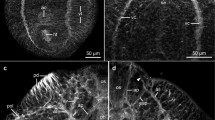Summary
An antiserum to the sequence Arg-Phe-amide (RFamide) was used to stain the nervous systems of various physonectid siphonophores. In the stem of Nanomia bijuga, this antiserum stained an ectodermal nerve net, which was interrupted, at regular intervals, by transverse collars of neurons. Injection of Lucifer yellow into the “giant axon” of the stem showed that this axon was dye-coupled to an ectodermal nerve net that resembled the RFamide-positive network. Ectodermal nets of neurons were also found in the pneumatophore, gastrozooids, tentacles and tentilla. At the junctions of the pneumatophore, the gastrozooids, the dactylozooids and the gonozooids with the stem, and at the junctions of tentacles and tentilla, collars or rings of neurons occurred. The stem was connected to the phyllozooids and nectophores by muscular lamellae, which were bordered by chains of neurons. At the margin of the nectophores, an immunoreactive nerve ring was found. Connected to this ring and located in the“seitliche Zapfen” (“sidely-located patche”), were two agglomerations of nerve cells. On the upper side of the bell margin, positioned at 90° relative to the “seitliche Zapfen”, a delta-shaped neuronal structure was found. This structure was connected to the nerve ring and was associated with a muscle, which ran a short distance along the exumbrellar surface.
The nervous systems of Agalma elegans, Forskalia edwardsi, Forskalia leuckarti and Halistemma rubrum resembled that of Nanomia bijuga in all major respects.
Similar content being viewed by others
References
Anderson PAV, Mackie GO (1977) Electrically coupled, photosensitive neurons control swimming in a jellyfish. Science 197:186–188
Claus C (1878) Über Halistemma tergestinum n. sp. nebst Bemerkungen über den feinern Bau der Physophoriden. Arb Zool Inst Univ Wien 1:1–56
Grimmelikhuijzen CJP (1983a) FMRFamide immunoreactivity is generally occurring in the nervous systems of coelenterates. Histochemistry 78:361–381
Grimmelikhuijzen CJP (1983b) Coexistence of neuropeptides in hydra. Neuroscience 9:837–845
Grimmelikhuijzen CJP (1984) Peptides in the nervous system of coelenterates. In: Falkmer S, Håkanson R, Sundler F (eds) Evolution and tumor pathology of the neuroendocrine system. Elsevier, Amsterdam, pp 39–58
Grimmelikhuijzen CJP (1985) Antisera to the sequence Arg-Pheamide visualize neuronal centralization in hydroid polyps. Cell Tissue Res 241:171–182
Grimmelikhuijzen CJP, Graff D (1985) Arg-Phe-amidelike peptides in the primitive nervous systems of coelenterates. Peptides 6 [Suppl 3]:477–483
Grimmelikhuijzen CJP, Spencer AN (1984) FMRFamide immunoreactivity in the nervous system of the medusa Polyorchis penicillatus. J Comp Neurol 230:361–371
Grimmelikhuijzen CJP, Dockray GJ, Schot LPC (1982a) FMRFamide-like immunoreactivity in the nervous system of hydra. Histochemistry 73:499–508
Grimmelikhuijzen CJP, Dierickx K, Boer GJ (1982b) Oxytocin/ vasopressin-like immunoreactivity is present in the nervous system of hydra. Neuroscience 7:3191–3199
Jha RK, Mackie GO (1967) The recognition, distribution and ultrastructure of hydrozoan nerve elements. J Morphol 123:43–62
Kölliker A (1853) Die Schwimmpolypen der Siphonophoren von Messina. Engelmann, Leipzig
Korotneff A (1884) Zur Histologie der Siphonophoren. Mitt Zool Sta Neapel 5:229–288
Mackie GO (1964) Analysis of locomotion in a siphonophore colony. Proc Roy Soc [Biol] 159:366–391
Mackie GO (1965) Conduction in the nerve-free epithelial of siphonophores. Am Zoologist 5:439–453
Mackie GO (1973) Report on giant nerve fibres in Nanomia. Publ Seto Mar Lab 20:745–756
Mackie GO (1976) The control of fast and slow muscle contractions in the siphonophore stem. In: Mackie GO (ed) Coelenterate ecology and behavior. Plenum Press, New York, pp 647–659
Mackie GO (1978) Coordination in physonectid siphonophores. Mar Behav Physiol 5:325–346
Mackie GO (1984) Fast pathways and escape behavior in Cnidaria. In: Eaton RC (ed) Neural mechanisms of startle behavior. Plenum Press, New York, pp 15–42
Mackie GO, Boag DA (1963) Fishing, feeding and digestion in siphonophores. Pubbl Staz Zool Napoli 33:178–196
Mackie GO, Singla CL, Stell WK (1985) Distribution of nerve elements showing FMRFamide-like immunoreactivity in Hydromedusae. Acta Zool Stockh 66:199–210
Price DA, Greenberg MJ (1977) Structure of a molluscan cardioexcitatory neuropeptide. Science 197:670–671
Schaeppi T (1898) Untersuchungen über das Nervensystem der Siphonophoren. Jena Zeit Naturwiss 25:483–550
Schneider KC (1892) Einige histologische Befunde an Coelenteraten. Jena Zeit Naturwiss 20:379–462
Spencer AN (1981) The parameters and properties of a group of electrically coupled neurones in the central nervous system of a hydrozoan jellyfish. J Exp Biol 93:33–50
Spencer AN, Arkett SA (1984) Radial symmetry and the organization of central neurones in a hydrozoan jellyfish J Exp Biol 110:69–90
Totton AK (1965) A synopsis of the Siphonophora. Trustees of the British Museum (Natural History), London
Triepel J, Grimmelikhuijzen CJP (1984a) A critical examination of the occurrence of FMRFamide immunoreactivity in the brain of guinea pig and rat. Histochemistry 80:63–71
Triepel J, Grimmelikhuijzen CJP (1984b) Mapping of neurons in the central nervous system of the guinea pig by use of antisera specific to the molluscan neuropeptide FMRFamide. Cell Tissue Res 237:575–586
Author information
Authors and Affiliations
Rights and permissions
About this article
Cite this article
Grimmelikhuijzen, C.J.P., Spencer, A.N. & Carré, D. Organization of the nervous system of physonectid siphonophores. Cell Tissue Res. 246, 463–479 (1986). https://doi.org/10.1007/BF00215186
Accepted:
Issue Date:
DOI: https://doi.org/10.1007/BF00215186




